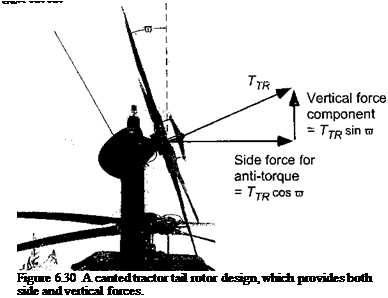Thrust Requirements
The primary purpose of the tail rotor is to provide a sideward force on the airframe in a direction and of sufficient magnitude to counter the main rotor torque reaction. The tail rotor also provides the pilot with directional (yaw) control. Roughly, the tail rotor consumes up to about 10% of the total power for the helicopter, although allowances of up to 20% may

![]()
![]()
 |
be made for design purposes to ensure sufficient maneuvering and transient capabilities. This is power that is completely lost, because unless the tail rotor is canted, as on the UH-60 Blackhawk (Fig. 6.30), it provides no useful lifting force. The purpose of the canted tail design is to widen the allowable center of gravity of the helicopter. This design, however, introdi
a flight control system.
The direction of the anti-torque force depends on the direction of rotation of the main rotor. For a rotor turning in the conventional direction (counterclockwise direction when viewed from above), the tail rotor thrust is to the right (starboard). The magnitude of this thrust, as well as its power consumption, depends on the reaction torque from the main rotor, Qmr, and the location of the tail rotor from the center of gravity (i. e., the moment arm Imr)- In addition, there are inertial effects that the tail rotor must overcome during yawing maneuvers. In this case, the tail rotor thrust can be found from
Qmr + hz^ — TtrItr (6.37)
where Ф is the yaw acceleration and Izz is the mass moment of inertia of the helicopter about the yaw axis.
The tail rotor thrust is controlled by the pilot’s feet by pushing on a set of floor mounted pedals. For example, for a rotor turning in the conventional direction pushing on the left pedal increases tail rotor thrust (positive to starboard) and the helicopter will yaw nose left about its center of gravity. The tail rotor must also provide the specified yaw acceleration in the maximum specified crosswind conditions, taking into consideration possible losses in efficiency because of aerodynamic interference effects between the tail rotor and the vertical fin – see Section 6.9. Furthermore, when the main rotor thrust or power is increased, for example, to climb, the reaction torque, Qmr, on the fuselage is increased. This means that the tail rotor thrust must also increase to balance this torque reaction. Therefore, when the pilot increases the collective pitch to climb, foot pressure must be applied to the appropriate pedal to keep the nose pointed straight in the desired direction of flight.











